Menus
- Part 2 comparison test on the country road
- Which motorcycles are missing in this test??
- Sportbikes against Russian Antonov AN-2P?
- "Good motorcycling starts with self-control!"
- Aprilia RSV4 RF is classy and radical
- RF version limited to 500 copies
- BMW S 1000 RR optionally with cruise control
- Shows the current and maximum bank angle in the cockpit
- Ducati 1299 Panigale S with real punch
- Advertised with 205 hp, 197 hp in appearance, 201 hp in real terms
- Honda Fireblade SP purrs like a kitten
- As a two-seater, I would come a long way in this test
- Kawasaki ZX-10R lies like an arrow, highly stable
- ZX-10R with adjustable footrests
- Suzuki GSX-R 1000 2015 also with ABS
- Yamaha YZF-R1 lightest four-cylinder in this class
- You are almost on the Yamaha
- MOTORCYCLE test result
- Technical specifications
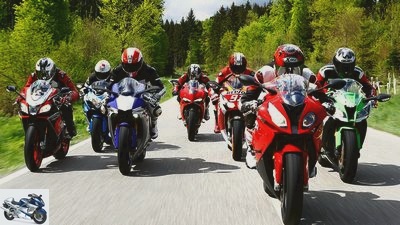
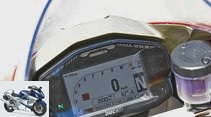
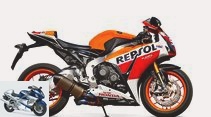
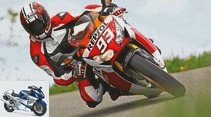
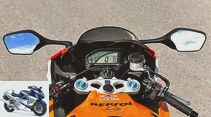
34 photos
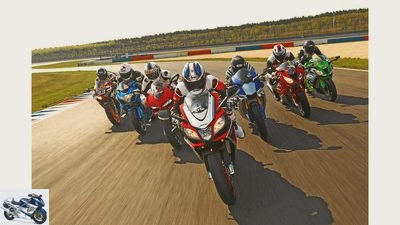
1/34
For the 11/2015 issue of MOTORRAD, the Supersport septet rode the “Masterbike 2015” at the great Lausitzring in Brandenburg.
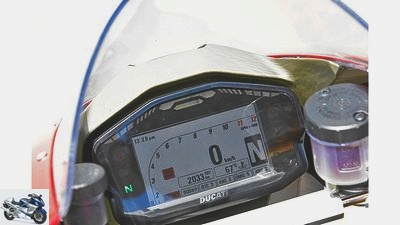
2/34
Beautifully colorful: The easy-to-read TFT display spoils you with lots of information – in the street and race track view.
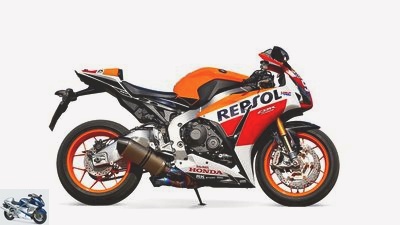
3/34
Honda Fireblade: The SP version of the Fireblade has Ohlins suspension elements and a classy Akrapovic silencer. Furthermore, Brembo monoblock brake calipers and a more delicate rear frame. Therefore she is a single seater. The hot “Repsol” finish is also available for the standard blade.

4/34
Characteristic: With the starting number 93 of the reigning MotoGP world champion Marc Márquez, the colorful Fireblade makes a sporty and chic look. Now another V4 …
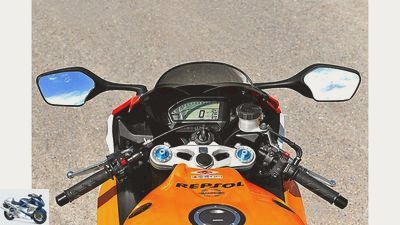
5/34
The effective handlebar width here is quite an impressive 69 centimeters.
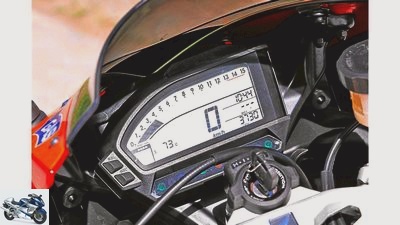
6/34
The cockpit only offers the most necessary information (see table on page 40) – including a moderately readable LCD tachometer.
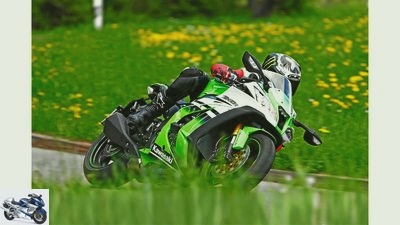
7/34
Kawasaki ZX-10R: 2011 was Japan’s first 200 horsepower reaction to the BMW S 1000 RR, released a year earlier. Typical: low, pointed fairing front and noble titanium manifold in front of the angular exhaust. Tri-color paint (“30th Anniversary Edition”) costs extra.
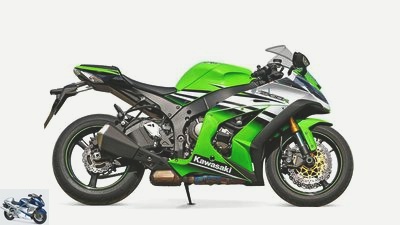
8/34
A wiry wedge, the Kawasaki. The kicks! Especially in long, fast corners. The ZX-10R was the homologation base for the Superbike World Championship motorcycle from 2013.
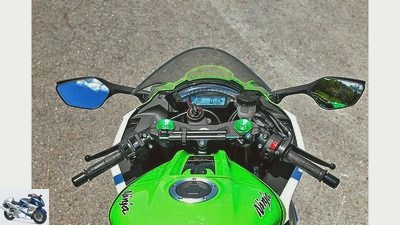
9/34
Handlebar width: 66.5 cm.
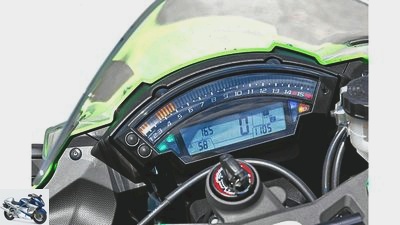
10/34
The high-contrast LED tachometer also serves as a shift light. Somewhat small: the gear indicator.
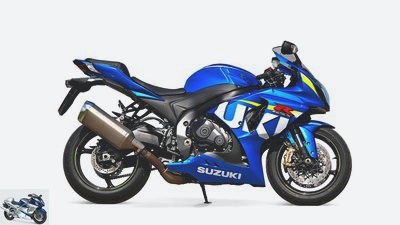
11/34
Suzuki GSX-R 1000: As the cheapest super sports car of this septet, the “Kilo-Gixxer” like the Honda Fireblade has to get along without traction control. Instead of many technical highlights, the GSX-R shines with a lot of power at medium speeds and paintwork à la MotoGP.
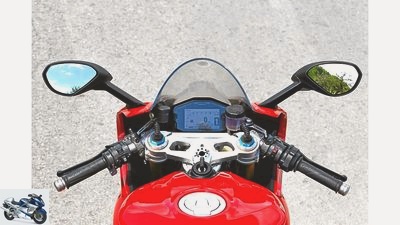
12/34
Handlebar width: full 71 cm.

13/34
Red goddess: gifted forms. The strut on the left side is extravagant. The Panigale is noticeably stronger than the 1299, better drivable and more comfortable.
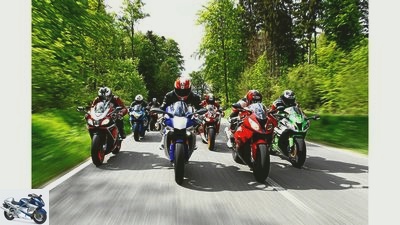
14/34
Aprilia RSV4 RF, BMW S 1000 RR, Ducati 1299 Panigale S, Honda Fireblade SP, Kawasaki ZX-10R, Suzuki GSX-R 1000, Yamaha YZF-R1 in comparison test.
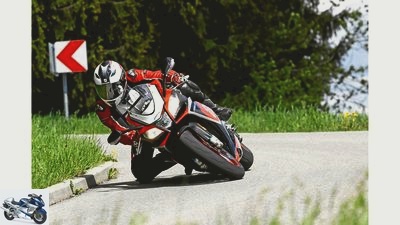
15/34
Aprilia RSV4 RF: The sensual and famous Aprilia cuts through curves like a laser beam through butter: high-precision, very predictable, ultra-stable.
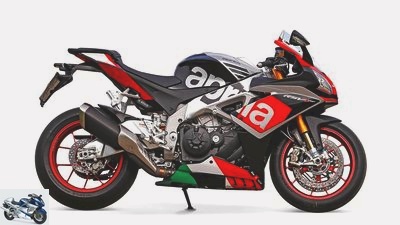
16/34
Aprilia RSV4 RF: Both 2015 RSV4 variants promise a full 201 hp – their V4 drive unit has been heavily revised …
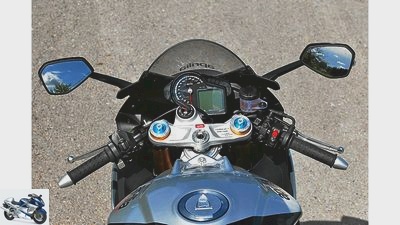
17/34
… The top version RF (“Factory”) offers a conventionally adjustable Ohlins chassis, forged wheels, adjustable Ohlins steering damper and tricolor paint kit.
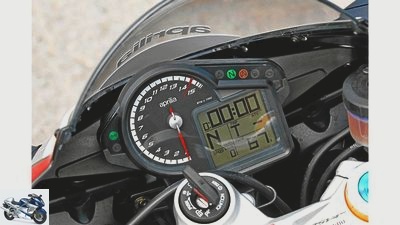
18/34
Clearly structured cockpit with a large analog tachometer and unadorned LCD information. Effective handlebar width: 68 centimeters.
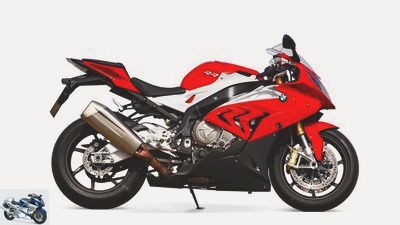
19/34
BMW S 1000 RR: State of the Art: Numerous assistance systems, electronically adjustable chassis and the also optional, lightweight HP forged wheels offer a worthy setting for power plus. In 2015 the muffler grew to compensate for the omitted front silencer.
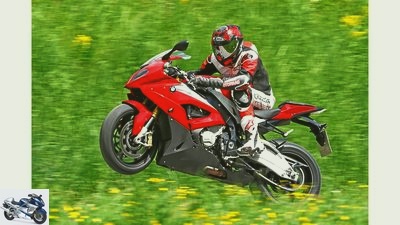
20/34
Extraordinary: The measured 212 hp BMW four-cylinder is always good for a little power wheelie. Unbelievable, this boost beyond the 12,000 mark!
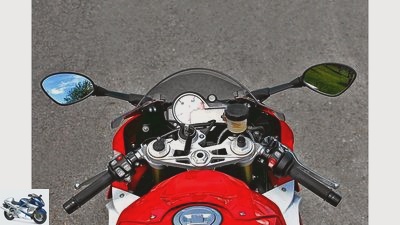
21/34
Handlebar stub: 67 cm wide.
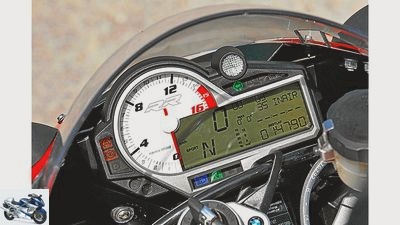
22/34
Infotainment: LCD displays save the values achieved for lean angle and deceleration.
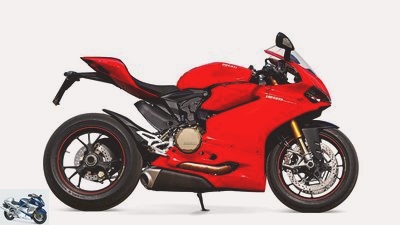
23/34
Ducati 1299 Panigale S: The most powerful series two-cylinder of all
Times (201 HP) carries huge pistons: full 116 millimeters bore! The two underfloor exhausts sound chubby. The S version has electronically controlled Ohlins spring elements and lightweight forged wheels. The lightest superbike at 194 kilograms!
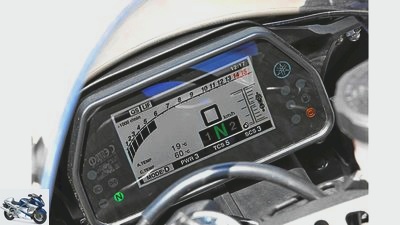
24/34
Modern: informative, colorful, easy-to-read cockpit with displays for brake pressure / inclination.
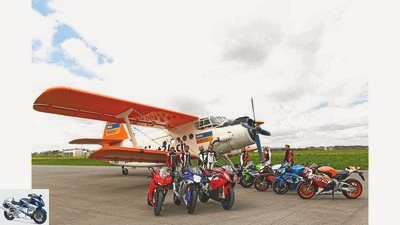
25/34
Contrasting program: The Antonov AN-2 is the world’s most powerful single-engine double-decker, thanks to its 1000 hp nine-cylinder radial engine.
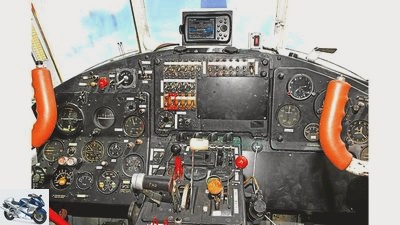
26/34
Everything analog: On board the Antonov AN-2 – built in 1973 – with its impressive collection of clocks, electronics is still a foreign word. In contrast to current supersport bikes as messengers from the future.

27/34
Four times Japan, three times Europe, six four-, one two-cylinder, but seven times ducking down in front of the oncoming wind with up to two and a half times a hurricane.
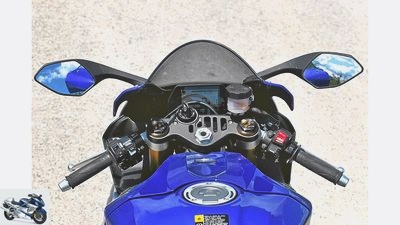
28/34
Handlebar width: 65.5 cm.
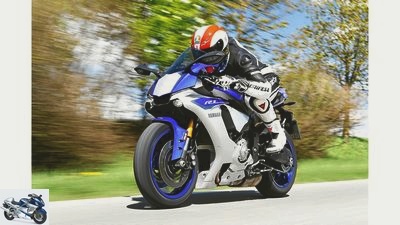
29/34
Race-racy: The seating position is sporty and compact. A design à la racing motorcycle with XXL start number field and LED headlights next to the air inlet.
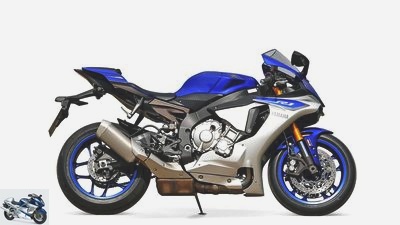
30/34
Yamaha YZF-R1: Aero-dynamics: The lining of the R1 looks airy and filigree, optically highlights the lightweight construction – 199 kilograms make the Yamaha the lightest four-cylinder in this class. Consistent: silencers made of expensive titanium, consistently in two-tone dress up to the rims.
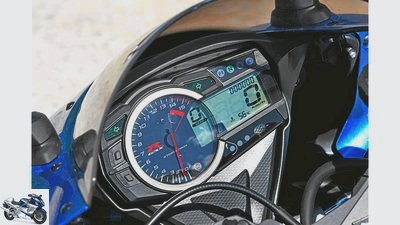
31/34
Fine: huge, conventional tachometer.

32/34
The narrowest handlebar stubs: 63.5 centimeters.
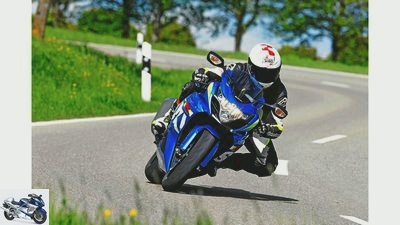
33/34
Still fully involved: the rather old GSX-R looks really good on country roads and can do a lot in the thicket of bends.
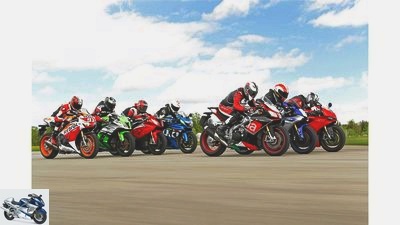
34/34
Head to head race? Only in terms of performance. Otherwise, the glorious seven set very individual accents!
Seven sports motorcycles in the country roads classification
Part 2 comparison test on the country road
Aprilia RSV4 RF, BMW S 1000 RR, Ducati 1299 Panigale S, Honda Fireblade SP, Kawasaki ZX-10R, Suzuki GSX-R 1000 and Yamaha YZF-R1 competed on the racetrack in the first part of the test. Now comes the country roads rating.
F.otermin at the Neuhausen ob Eck airfield. Seven motorcycle engines with a total of 26 cylinders and a full 1363 hp rated power grumble to themselves while idling. Only flying is more beautiful. Ernst Leverkus, known as Klacks, once called motorcycling “flying on earth”. Playing with lean angle, longitudinal and lateral acceleration, roll and yaw rates. Movement in two and a half dimensions. Then these super sports cars correspond to fighter jets, built for life at the limit. Strong, light, extreme. Everything for maximum performance and spectacular maneuvers.
Buy complete article
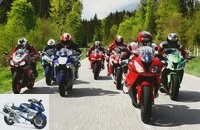
Seven sports motorcycles in the country roads classification
Part 2 comparison test on the country road
Fireblade SP and Suzuki GSX-R 1000, to bring excessive performance down to earth. Made possible by complex software and ride-by-wire. The equipment list shows: The field of seven is not homogeneous – here four machines against three machines.
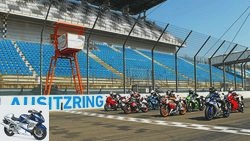
Super athlete
Seven super athletes in the track test
Part 1 comparison test on the racetrack
read more
Which motorcycles are missing in this test??
What less the four Japanese mean against the three Europeans. But rather the new or heavily revised models Aprilia RSV4 RF, BMW S 1000 RR, Ducati 1299 Panigale S and Yamaha YZF-R1 against the three Supersport youngtimers Honda Fireblade SP, Kawasaki ZX-10R and Suzuki GSX-R 1000. Those are much more sparsely equipped, especially the Fireblade. The Yamaha YZF-R1M would have an electronically regulated chassis for 23,000 euros. But this premium version is sold out in Germany and was therefore not available for this test. So the standard version with a conventional chassis has to work.
Who is still missing? First, the 173 hp KTM 1190 RC8 R, because it is being phased out and will no longer be developed. Also the MV Agusta F4 1000 RR, four-cylinder in Italian. A new model will follow in 2016, lighter and stronger, more modern and more compact. The irony of fate: Kawasaki’s H2 compressor rocket was supposed to be the starting point for this test. With many loans from Kawasaki’s aircraft division. Black and evil like the Lockheed SR-71 Mach 3 jet. But we’re still waiting for the kawa.
Sportbikes against Russian Antonov AN-2P?
Not bad, because even so we have a colorful field together. This means more than glowing paintwork, bright warning colors. Four conventional in-line four-cylinder (BMW, Honda, Kawasaki, Suzuki), a typical 90-degree V2 from Ducati and two V4 engines: a real one with a 65-degree cylinder angle from Aprilia plus a fake one, because the crankshaft of the Yamaha YZF-R1 mimics a 90 degree V4.
But first, another vehicle, booming loudly, pushes onto the runway: a Russian Antonov AN-2P with Swiss registration. The world’s largest single-engine double-decker almost steals the show from the seven super sports cars. Its nine-cylinder radial engine has 1000 hp. Pilot Daniel Reichner explains his machine, which has been baptized “Anastasia” (information: www.antonov.ch). It is built in 1973, a messenger from another era. “There is absolutely nothing electronic here.” The “tractor of the air”, as the Antonov was called in the GDR, is 150 meters enough to take off. Which the double-decker also demonstrates spectacularly.
"Good motorcycling starts with self-control!"
Pah! At 150 meters, our cars jump from a standing start to 175 km / h. Provided that you are familiar with the throttle, clutch and, ideally, wheelie control. The BMW S 1000 RR sprints from zero to 200 in 7.1 seconds! Hardly any slower: the 7.5 seconds of the Suzuki GSX-R 1000. With measured 175 HP in the Supersport-Suzi up to an unbelievable 212 HP in the BMW, this duo sets the extremes of our superbikes. Does anyone still remember the voluntary 100 hp limit in Germany? 33 years ago the 100 hp superbikes were still called the Honda CB 1100 R, Kawasaki GPZ 1100 and Suzuki GSX 1100 Katana. They weighed over 250 kilograms.
At that time MOTORRAD said: “You can still overtake with it if you can already see the white in the eye of the oncoming.” What should you say today, given the astronomical power weights of one kilogram per hp and below?
Aprilia RSV4 RF: 207 kilograms, real 203 hp; BMW S 1000 RR 205 kilograms, 212 hp; Ducati 1299 Panigale S: 194 kilograms to 201 hp, Yamaha YZF-R1: 199 kilograms and just as many hp. Geez. Everything on production motorcycles with license plates and lights, not on thoroughbred racing machines.
The CBR 1000 RR pushes a maximum of 180 hp with a dead weight of 212 kilograms. The Honda Fireblade SP is a single-seater. The Kawasaki ZX-10R, which weighs 203 kilograms, has 194 hp. The equally heavy Suzuki GSX-R 1000 lets 175 horses trot. This top-class field just shifts perception. As “Klacks” said: “The art of good motorcycling begins with self-control! Woe to anyone who cannot keep his temper in check! “
Aprilia RSV4 RF is classy and radical
Both 2015 RSV4 variants promise a full 201 hp – their V4 drive unit has been heavily revised.
The Aprilia RSV4 RF is a real temptation, classy and radical. Aprilia advertises “Be a Racer”. More than the usual Italian attitude: the brand from Noale won 54 world titles and is the reigning world champion superbike. And this is the homologation motorcycle. In 2015 there were many new parts in the 65-degree V4: CNC-milled cylinder heads, titanium valves with new springs, modified variable intake funnels, flow-optimized air boxes, lighter camshafts (600 grams) and upper engine housing halves (1.3 kilograms), optimized oil circuit and, and and.
A damn delightful experience to grab this fascinating, invigorated V4 bull by the horns. From 5000 revolutions the power cube comes alive and outstrips the R1 from now on. Underneath, it takes a little breath, but with the exhaust flap still closed, it can be moved quite quietly. The Aprilia RSV4 RF turns up enthusiastically, up to 13,700 tours. If you do that, it growls characteristic, sounds like a whole paddock. A very sensual drive. Its noticeable pulsation is simply part of it.
The Italo chassis is a fulfillment. With it you can even set the exact engine position, steering head angle and the swing arm axis. A racing motorcycle for the road. The agile Aprilia RSV4 RF plunges into curves like a peregrine falcon swoops down on birds. Hungry for curves, greedy. The steering precision is razor-sharp, light as a feather in handling (small gyroscopic forces due to the narrow crankshaft as with the Duc!), Great in mechanical traction (swing arm extended by four millimeters). The RSV4 drives enthusiastically and seems to know telepathically what its driver wants. A feedback world champion with crystal clear feedback. The tightly damped Ohlins spring elements scan the asphalt relief as sensitively as a seismograph.
All reviews and articles about the Aprilia RSV4 RF
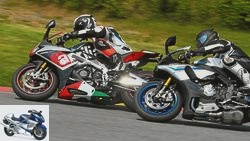
Super athlete
Aprilia RSV4 RF and Yamaha YZF-R1M in comparison test
Racing duel of the giants
read more
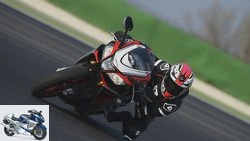
Super athlete
Aprilia RSV4 RF (2015) in the driving report
The best for last?
read more
RF version limited to 500 copies
Together with lightweight forged wheels, adjustable Ohlins steering damper and tricolor paintwork, they are the hallmarks of the RF version, limited to 500 copies, for a proud EUR 21,490. After all, the chassis components can be retrofitted to the 3000 Euro cheaper standard type RR. It has cast wheels and Sachs spring elements as standard. The Brembo stoppers bite wonderfully transparent and powerful, the Bosch ABS is sporty. The colorful bird of paradise can be wonderfully slowed into the curves. The electronics package is well thought-out; the traction control, which can be switched off, can be quickly and easily adjusted in eight stages using the plus / minus button, even in the heat of the moment.
Aprilia breaks the voluntary self-limitation of 299 km / h. The vehicle registration says macho “305” as Vmax, and the RSV actually runs it. The Antonov can only do this in a dive. The Aprilia RSV4 RF requires compromises in everyday life, comfort is not its thing. Crazy: A smartphone app controls the coordination of traction and wheelie control in real time via GPS for 15 stored racetracks in Europe, depending on the track sector. Even without this gimmick, the RSV4 RF won the masterbike at the Lausitzring in MOTORRAD 11/2015. Congratulations.
BMW S 1000 RR optionally with cruise control
BMW S 1000 RR: Numerous assistance systems, electronically adjustable chassis and the also optional, lightweight HP forged wheels offer a worthy setting for power plus.
The BMW S 1000 RR is now blowing its revenge on public roads. It is five kilograms lighter than the 2014 model, thanks to the omission of the exhaust collector in front of the enlarged silencer and lighter HP forged wheels for 1200 euros. In addition, there is a lot of fine-tuning on the chassis and engine (cylinder head), equipment and electronics. BMW systematically and consistently even focuses on small details. This is the secret of success: never rest too long! The heated grips of this super sports car are already legendary – and so comfortable on cool spring evenings. New in 2015: the optional cruise control.
A real force, this BMW engine. How he pushes, always pushes. Despite the large gear indicator, you are always looking for seventh gear in vain, because you can hardly believe such an excess of thrust. In sixth gear from 60 to 180 km / h in 9.0 seconds, that borders on pulling world champions! It is the shortest-stroke four-cylinder. Squaring the circle. The icing on the cake is the silky smooth throttle response and complete predictability. From above, the BMW S 1000 RR storms forward as if fired from a catapult. Wild unleashes even over 250 km / h as if an angel is pushing. Reality shifts at 212 hp, trucks drive backwards. An extra power shower fires the surface-to-surface missile at 11,500 rpm when the intake funnels rise. Testosterone tuning.
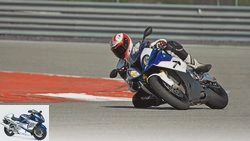
Super athlete
BMW S 1000 RR in the driving report
Heavily revised Bayern Express
read more
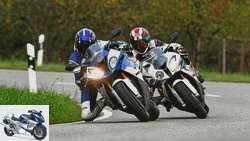
Super athlete
BMW S 1000 RR old versus new in the test
All things new. But also better?
read more
Shows the current and maximum bank angle in the cockpit
Accompanied by a sonorous sound, wroup, wroup, wroup, the connections always fit perfectly. With the automatic gearshift, the gears slip in both directions without actuating the clutch: fully cock the tap and push it up or close the smooth-running electric throttle completely to downshift – then the electronics even double-declutch. All assistance systems work almost ideally, inconspicuously in the background and finely adjustable. The bearish BMW S 1000 RR scores 218 of a possible 250 points in the engine ranking. Any questions? The balancing hum, which became more manageable in 2015, steers in nicely directly, drives really sharp, crisp lines if necessary.
And even shows this: With the optional Race Package, your cockpit reports the current and maximum bank angle and braking delay. You have to be amazed. The semi-active chassis responds well and offers the highest level of suspension comfort in the field. The well-balanced BMW S 1000 RR can even go slowly (city traffic), and with its combination brake provides maximum safety. The seating position is compact, quite upright and a bit wide-legged. This ingenious motorcycle hardly has any weaknesses. In this respect, the 20,500 euros for the Bayern bomber including all the extras don’t even seem overpriced.
Ducati 1299 Panigale S with real punch
Red goddess: the Ducati 1299 Panigale S. Extravagant the strut on the left side.
The Ducati 1299 Panigale comes as an S version even more than 5000 euros. A premium milling machine with forged aluminum wheels, semi-active Ohlins chassis, electronic steering damper, LED headlights and carbon front fenders. The world’s strongest production two-cylinder, with 1285 cc, is in a league of its own, outside the Superbike regulations. Yes and? We’re on the road, not in the World Cup. Here the largest series pistons hammer the crankshaft with a massive 140 Newton meters. More torque for less turning moment: the Desmo-V2 brushes the sails at 11,000 tours.
With the 1299, in contrast to the 1199 Panigale, there is also real pressure in the middle of the boiler. Real punch, Mach2 on earth! The Ducati 1299 Panigale S surpasses the six 1000s by a world with a 30 percent increase in displacement. Their huge individual cubic capacities (642.5 cm³) have almost twice as much bore as stroke! The ultra-short-stroke with the four injection nozzles thunders out of its two exhaust pipes on the lower ground floor, so that the windows in the house facades wobble. Almost embarrassing. The “culture” run is also of a rather lumpy nature. It polarizes, the wildly pounding Panigale. You love or you hate them.
Advertised with 205 hp, 197 hp in appearance, 201 hp in real terms
Strange: Ducati advertises the Panigale 1299 with 205 hp at 10,500 rpm, but the vehicle registration document says “only” 197 hp. Then the high-torque grenade stacks deep with real 201 hp. As with the BMW S 1000 RR, the automatic gearshift works in both directions, but needs more emphasis. He interrupts the ignition / injection a bit longer. But still clears your mind. Meanwhile, the clutch hand can quickly adjust the engine brake (!), Traction and wheelie control while driving. The broadly exposed handlebar stumps follow the love or hate steering impulses willingly and directly. It drives more harmoniously, rounder and softer than the 1199.
Because it holds tighter lines with less effort, the thicker driver’s seat has. And its shock absorber is much more sensitive. The fork is a poem anyway. The electronic regulation of the damper valves works fine. Whether on bumps, in potholes or when braking / accelerating – it works exactly and quickly. Unlike the 1199, this chassis also works with micro-lifts in the asphalt. Bosch’s ABS cornering is aggressively anchored. Ultimately, the 1299 needs a bit of getting used to compared to the rest of the six. It is not a very easy motorcycle to drive. But emotionally very big cinema.
All tests and articles about the Ducati 1299 Panigale S.
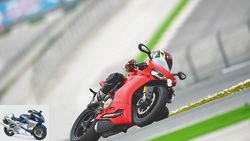
Super athlete
Ducati 1299 Panigale S in the driving report
Sports cannon through and through
read more

Super athlete
Ducati 1299 Panigale S and Ducati 1199 Panigale S in comparison test
What can the new one do better??
read more
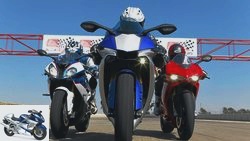
Super athlete
BMW S 1000 RR, Ducati 1299 Panigale S and Yamaha YZF-R1 in a comparison test
Circuit comparison
read more
Honda Fireblade SP purrs like a kitten
Honda CBR 1000 RR Fireblade: With the starting number 93 of the reigning MotoGP world champion Marc Márquez, the colorful Fireblade makes it hard to look sporty and chic.
It was a pioneer in 2009, the still current Honda Fireblade: the world’s first super sports car with ABS, together with its 600 sister! Unthinkable today without moving out. Very complex, these Honda brakes: A real “brake-by-wire” in which digitally controlled servo pumps and solenoid valves build up the brake pressure and distribute it between the front and rear wheels. Not to feel that you are not directly pinching the fine Brembo monoblocks yourself. Together with the Ohlins chassis, carbon fenders and other triple clamps, they are the hallmark of the single-seat SP version.
The engine of the Honda Fireblade SP is identical to that of the standard fire blade. However, selected pistons work in it with a weight difference of no more than one gram. The spirit of perfection! This drive is not an angry berserker, only switches on the afterburner beyond 10,000 revolutions. Until then, the in-line four is always under the Suzuki drive. The engine purrs like a kitten and stays nice and quiet even with an Akrapovic exhaust. Conventionally operated by gas cables, it hangs softly, not aggressively on the gas. The slipper clutch works smoothly. The smoothness is at a medium level – it tingles more when you take the gas off. Load change reactions are definitely noticeable when gas-to-gas-to-gas-again-open.
As a two-seater, I would come a long way in this test
Like a Honda, the Fireblade sails through curves of every color: predictable, good-natured, almost unspectacularly fast. Even if the first steering impulse takes a bit more verve than with the very modern machines. The steering head is the steepest of all at 66.7 degrees. The Honda Fireblade SP uses the same handy Pirelli Supercorsa SP Supersport skins as the Ducati. This means that it implements even tight lines with true tracking, and does what the driver wants in a user-friendly way. The Swedish spring elements are inherently quite tight. Unscrewing the damper screws makes them much more comfortable.
That fits the meek, balanced character. You can even forgive the lack of traction control. And the somewhat wide-legged sitting position. The MotoGP 2014 win is proudly emblazoned on the tank: driver, constructor and team world championship. It would be nice for the Honda disciples if a little more racing tech inspired the next Blade. Nevertheless, the Honda Fireblade SP would come far ahead as a two-seater in this test. compliment.
All tests and articles about the Honda Fireblade SP
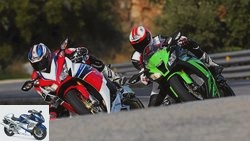
Super athlete
Honda Fireblade SP and Kawasaki ZX-10R in the test
High-performance reactors on country roads and racetracks
read more
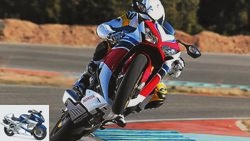
Super athlete
Honda Fireblade SP in the PS performance test
Prettified, smoothed and lifted
read more
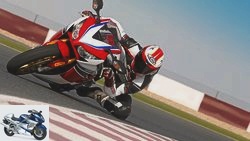
Super athlete
Honda CBR 1000 RR Fireblade SP in the driving report
Refinement and Precision
read more
Kawasaki ZX-10R lies like an arrow, highly stable
A wiry wedge, the Kawasaki ZX-10R. The kicks! Especially in long, fast corners.
Unlike the Honda, the Kawasaki ZX-10R has ride-by-wire and traction control. However, with pistons of exactly the same size, it pushes less power up to the 11,000 mark. Whining at the highest level? Not quite. The fireworks are only raging above, in the speed cellar one expects more smoke from the poison green brand with the power karma. The pull-through values from 60 to 140 (7.6 seconds) are the least rapid of the entire septet. In serpentines you have to switch back a lot – on board a 1000. The rather small gear display catches the eye. So better count. First and second gear have a long ratio in terms of racing; mathematically, they reach speeds of up to 152 and 192 respectively!
As is typical for Kawasaki, the electronically operated throttle valves open a tad harder from the closed position than on any other machine. This delays the throttle response, needs a little concentration, is not for gross motorists on the throttle. Positive: the three-stage traction control and the three different motor mappings (full, medium, low) can easily be adjusted independently from the handlebars while driving. The expensive titanium manifolds formed with water pressure are noble. Too bad, this moderately beefy engine is not completely convincing. And the landing gear? In long, fast corners, the Kawasaki ZX-10R with its powerful swingarm is like an arrow, highly stable. There is something.
ZX-10R with adjustable footrests
Very tight radii, on the other hand, are not what the Kawasaki ZX-10R likes. This is where the series tires come into play: Bridgestone BT 016 with the special code “CC” do not seem to be the very latest material. Every now and then, irritating slides occur with them, both in front and behind. In addition, the steering behavior is not as harmonious and neutral as it was recently with the famous Bridgestone S 20. This newer Japanese tire is simply the better sports all-rounder. A little swipe: the Suzuki GSX-R 1000 carries it with the special code “F”. Other tires could presumably also make it more nimble, so the handling is only mediocre.
It feels like the Kawasaki ZX-10R stretches over the tank for a long time. It should be like that, after all, it’s a sports motorcycle. The adjustable footrests are great, so everyone can choose their position in the rather deep seat (81 centimeters seat height). Take care when turning: the handlebars come close to the tank, watch out for your fingers.

Super athlete
Honda Fireblade SP and Kawasaki ZX-10R in the test
High-performance reactors on country roads and racetracks
read more
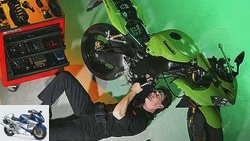
Super athlete
Endurance test final balance of the Kawasaki ZX-10R
Too good to be stripped
read more
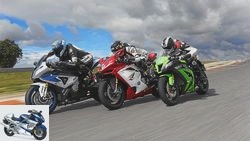
Super athlete
BMW HP4, Kawasaki ZX-10R, MV Agusta F4 RR
Top super sports cars from BMW, Kawasaki and MV Agusta
read more
Suzuki GSX-R 1000 2015 also with ABS
The rather old Suzuki GSX-R 1000 looks really good on country roads and can do a lot in the thicket of bends.
A rolling legend is the Suzuki GSX-R 1000, which has been setting trends since 2001, the K0. Now in the fifth and a half generation. GSX-R racers celebrated tremendous successes, won the World Endurance Championship nine times in ten years, and won tons of victories at the 24 Hours of Le Mans and at the Bol d’Or. Respect. “Knows every podium personally,” advertises Suzuki. But out on the street you hardly have the Kilo-Gixxer on the slip. After all, it has remained unchanged for five years. Nearly. In 2015 there will be the long-awaited ABS. And then finally more snappy brake pads. A giant step in the right direction. Even if the Brembo monoblocks don’t bite as aggressively here as with the other candidates and the ABS should regulate a little more finely.
The icing on the cake of the Suzuki GSX-R 1000 is its fine and stable, least short-stroke engine. He competes strongly, also from below. To do this, he works in a cultivated manner, hangs silky on the gas, changes load and hardly vibrates. Class! Only on the race track does the four-cylinder lack connection to the highest performance league. In real life he always has more than enough power. Already “no brainer” knew: “It is not the top speed of a machine that makes the driver a fast man, it is the high average on long journeys that makes him a master!” On the country road you almost never call up more than 70 or 80 hp.
Praiseworthy: Like the Honda Fireblade, the Suzuki GSX-R 1000 is particularly economical with fuel. They only consume 4.8 liters per 100 kilometers of defensively driven country roads. But the GSX-R 1000 and CBR 1000 RR are the candidates with the highest standard inspection times set ex works: Short 6000 maintenance intervals, in contrast to the Kawasaki always with oil change, are no longer up to date. The mobility guarantee provides security, just like with Aprilia, BMW and Ducati. Together with the Honda, the Suzi offers the best wind protection. However, it has the narrowest handlebar stubs. Nevertheless, it swings easily over winding, long country roads, obediently and precisely, waving easily through alternating curves. A great motorcycle. The somewhat wooden-looking shock absorber and the lack of traction control do nothing to change that.
All tests and articles about the Suzuki GSX-R 1000

Super athlete
Endurance test final balance Suzuki GSX-R 1000
Gixxer charm
read more
Yamaha YZF-R1 lightest four-cylinder in this class
The cladding of the R1 looks airy and filigree, optically highlights the lightweight construction – 199 kilograms make the Yamaha YZF-R1 the lightest four-cylinder in its class.
For the many friends of the Yamaha brand, the best comes for last, the completely redesigned Yamaha YZF-R1. A motorcycle that feels good from the first meter – compact, almost dainty like a 600. An arrow on wheels, sporty and sensual. The uneven firing order of the Big Bang four-cylinder plays its part in this. It ignites asymmetrically every 270-180-90-180 degrees. And therefore sounds like a V4 with a 90 degree cylinder angle, not like normal in-line four-cylinders that fire every 180 degrees (Aprilia V4: 180-65-180-295 degrees). On the R1 you can roll quietly through the city (g) and still enjoy good sound.
The pseudo-V4 of the Yamaha YZF-R1 is a real rotary engine. From 5,000 to 8,000 tours, this is the weakest drive, and that’s where things go. It is not without reason that the LCD tachometer switches from black to green at the 8000 mark (and to orange at 11,000 rpm) and shows the comfort level. So you catch yourself shifting down again and again, even on the highway. To board the second, more exciting half of the speed after a rapid increase in torque. Train belongs on the chain! Especially since the crossplane motor pulsates gently. You just have to accept the highest gasoline consumption. Exactly like armed load change reactions, for example in city traffic, in hairpin bends or when flying blind around invisible curves.
As is typical for Yamaha, the R1 jumps on the gas quite roughly, especially in A mode. Mode B makes it a little softer, the performance-capped third mode is much more gentle. The real highlight of this Nippon athlete is its one-a-side chassis. A fantastically precise low-flying aircraft through the curves, wonderfully round and precise – as if steered by a laser beam. Absolutely inspiring. Targeting the tightest radii? No problem. “The Yamaha YZF-R1 drives great over the front wheel,” say real racing drivers. In other words: It conveys a lot of trust and feedback from what is happening in front of and under you, and is easy to direct. There it was again, that 600 feeling.
You are almost on the Yamaha
Is it because of the ultra-short 1,405 millimeters wheelbase? Well, the Suzuki has that too. Or the light magnesium wheels? The painted aluminum tank also indulges in lightweight construction. Tip: The Yamaha YZF-R1 looks almost even sharper in red and white. Narrow LED light strips above the LED main headlights bring a lot of overtaking prestige – as slanted “slit eyes”. They improve the visibility. The same applies to the LEDs in the Honda mirrors. Sporty: You are almost lying on the Yamaha, not for people who want to look at planes in the sky. Bend down if you like it fast.
A “sensor cluster” works as the “central nervous system” (Yamaha) in the Yamaha YZF-R1, which records all movements of the vehicle in three dimensions and ensures traction, slip, wheelie inclination, launch control, drift angle (!) And braking . A calculator on wheels. The front four-piston calipers have different piston pairs of different sizes. Subjectively, they should bite even harder. Playing it safe: As with all Japanese, the ABS cannot be switched off on the R1. This motorcycle is not lacking in technical highlights. But in order to beat the BMW, it would still need a little fine-tuning.
All seven candidates are good for high-altitude flights close to the asphalt and, contrary to expectations, are in a good mood even with speed limits. Compliments to the rolling technology carriers, these missiles on wheels.
All tests and articles about the Yamaha YZF-R1

Super athlete
BMW S 1000 RR, Ducati 1299 Panigale S and Yamaha YZF-R1 in a comparison test
Circuit comparison
read more
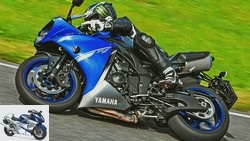
Super athlete
Zonko’s attack on the Yamaha YZF-R1
Too fat for this world
read more

Super athlete
Aprilia RSV4 RF and Yamaha YZF-R1M in comparison test
Racing duel of the giants
read more
MOTORCYCLE test result
1. BMW S 1000 RR She is and remains the high flyer in this airfield. Their magic word is drivability. Continuously further developed, even fundamentally revised, its engine is a power, the overall package in public road traffic remains unmatched.
2. Yamaha YZF-R1 An inspiring motorcycle with a top chassis even without semi-active dampers. Then there is the cool, easy-revving engine. And then “only” the second? Yes, because the torque curve, throttle response, load changes, consumption and range could be better.
3. Suzuki GSX-R 1000 A real surprise: Finally equipped with ABS, the Kilo-Gixxer is a really good and inexpensive motorcycle. The great four-cylinder, really powerful in the middle, easily covers the slightest peak performance, sparse equipment and a rather old chassis.
4. Ducati 1299 Panigale S. Expensive, noble and highly emotional: the red diva wants speed. The faster it gets, the better it works. At the same time, it is more comfortable and easy to handle than the 1199. The 1299 works even better on the Renne, where it unfolds its full potential.
5. Kawasaki ZX-10R 30 years of Ninja: The anniversary model of the current tens is reminiscent of the first GPZ 900R. After all, the racing version of the ZX-10 won the Superbike World Championship in 2013. The race-oriented Kawa also turns civilian streets on.
6. Aprilia RSV4 RF Forget sixth place. Of course, a racer for the road requires compromises in everyday life. But the RSV4 is a real magic motorcycle! For emotional drivers, even country roads with the fascinating V4 in the picture book chassis are a fulfillment.
Unplaced: Honda Fireblade A fine character, gentle and easy to drive. The values of the single-seat SP cannot be transferred directly to the standard CBR 1000 RR – the brake calipers and chassis are different. As a two-seater, the Blade would have the best chance of a podium.
Technical specifications
Related articles
-
Comparison test BMW S 1000 RR, Ducati 1299 Panigale S and Yamaha YZF-R1
fact 46 pictures fact 1/46 Yamaha YZF-R1. fact 2/46 BMW S 1000 RR. fact 3/46 The swing arm takes the wheel axle very far back – good for the …
-
Jahn comparison test of supersports: Ducati 998, Honda Fireblade, Kawasaki ZX-9R, Suzuki GSX-R 1000, Triumph Daytona 955i Centennial The K-Question Five …
-
Comparison test, Aprilia RS 250, Ducati 916, Honda Fireblade, Kawasaki Ninja ZX-6R, Suzuki GSX-R 750, Yamaha YZF 1000 R Aprilia RS 250, Kawasaki ZX-6 R, …
-
fact Concept comparison Honda CBR 1100 XX Kawasaki ZX-12 R Suzuki GSX-R 1000 Suzuki GSX 1400 Yamaha FZS 1000 Fazer Yamaha FJR 1300 Six bombs The six …
-
factstudio.de 29 photos fact 1/29 One against all. Ducati SuperSport S in comparison test with Suzuki GSX-S 1000 F, Kawasaki Z 1000 SX, Honda VFR 800 F…
-
BMW, Honda, Kawasaki, Suzuki and Yamaha super sports cars in a comparison test
Judd 26 pictures Nicolaou 1/26 In the super sports car comparison test: Kawasaki ZX-10R, BMW S 1000 RR, Suzuki GSX-R 1000, Honda Fireblade C-ABS and Yamaha YZF-R1 ….
-
Honda Fireblade vs. Suzuki GSX-R 1000 in comparison test
Maccabelli The last four-cylinder without control electronics Test: Honda Fireblade against Suzuki GSX-R 1000 Contents of They are the last current …
-
Suzuki Hayabusa, Kawasaki Ninja H2, Aprilia RSV4 RF and Yamaha Vmax in the test
Bilski 41 photos Bilski 1/41 Yamaha Vmax, Suzuki Hayabusa, Aprilia RSV4 RF, Kawasaki Ninja H2. Each of these four machines has its own special charm….
-
Aprilia RSV4 Factory, Honda Fireblade, Yamaha YZF-R1
K Aprilia RSV4 Factory, Honda Fireblade, Yamaha YZF-R1 A day in the country Content of It’s summer, the planet stings, and the birds are chirping….
-
Ducati 999-1199, Kawasaki Z 1000 and Yamaha YZF-R1 in a comparison test
fact Ducati 999/1199, Kawasaki Z 1000 and Yamaha YZF-R1 Generation comparison – 10 years apart Contents of Ten years is a long time since …